Intel Unveils Lunar Lake Architecture: New P and E cores, Xe2-LPG Graphics, New NPU 4 Brings More AI Performance
by Gavin Bonshor on June 3, 2024 11:00 PM ESTIntel Lunar Lake: New E-Core, Skymont Takes Flight For Peak Efficiency
Intel also opts for their Skymont E-cores, which are designed more for efficiency while maintaining a solid level of performance at a lower power envelope.
The Skymont cores feature a significantly broader decode architecture, with a 9-wide decode stage that includes 50% more decode clusters than previous generations. This is supported by a larger micro-op queue, which now holds 96 entries compared to 64 in the previous Crestmont E-Cores.
Intel has improved the out-of-order execution engine by boosting the allocation width from 4 to 8 and the retire width from 8 to 16. The next-gen Skymont core is supposed to surpass Crestmont E-Cores with double the allocation and retire width in terms of its ability to commit and run out-of-order instructions, decreasing overall latency and minimizing stalling for data dependencies.
Queuing and buffering capabilities have also been improved within the Skymont E-Core. It features a deeper reorder buffer of 416 entries, up from the previous 256, while Intel claims the size of the physical register files (PRF) and INT, MEM, and Vectors have been made deeper, too.
Focusing on dispatch ports, Intel has opted for a similar approach to Crestmont. This includes 26 dispatch ports, 8 integer ALUs, 3 Jump Ports, and 3 for load operations per cycle. Regarding Vector performance, Skymont supports 4x128-bit FP and SIMD vectors, which doubles gigaflops/TOPs and reduces latency for floating-point operations.
Intel does provide some figures highlighting Skymont's power efficiency and performance when compared directly to the Low Power Island E-Cores included on the SoC tile on Meteor Lake. In this particular line chart, Intel increases single-threaded performance by 1.7X while consuming just one-third of the power relative to Meteor Lake's LP E-cores.
Looking at multi-threaded performance, Intel puts Skymont 2.9X faster at 1/3rd of the power requirements when compared to Meteor Lake and the LP E-cores. It's worth noting that the Skymont E-Core cluster on the compute tile has double the cores of the Meteor Lake LP E-Core cluster (4 vs. 2), so performance is expected to be higher overall.
Due to their low-powered nature for mobile devices such as notebooks, the Skymont E-cores are designed to be very flexible, with some leverage over previous E-Core architectures. Compared to Raptor Cove, Skymont offers 2% better integer and floating-point performance in single-threaded workloads, with a power and thermal envelope almost identical to Raptor Cove. This is in a more desktop-friendly environment, as Intel does depict the data with the Skymont cores on an LLC or a Ring Bus. This is E-Cores versus the previous gen of P-Cores, in which Intel is claiming a 2% lead.
Intel's Skymont E-cores represent the next leap in Intel's architectural development. According to Intel's disclosure, Skymont looks to be a marked improvement in multiple areas over the previous Crestmont E-Core, including decoding, execution, memory subsystems, and power efficiency. While Intel discloses them as E-Cores, the messaging surrounding Skymont is a little confusing.
The easiest way to decipher this is that they are similar to the two LP E-Cores within the Meteor Lake SoC tile, but with Lunar Lake, they are in a cluster of four built onto the compute tile. On Lunar Lake, they will be as efficient as the LP E-cores of old, but for desktop, they will be in a cluster on the chips Ring Bus, meaning they will likely be similar to the traditional E-cores we've seen before with Intel's 14th/13th/12th Gen Core families.


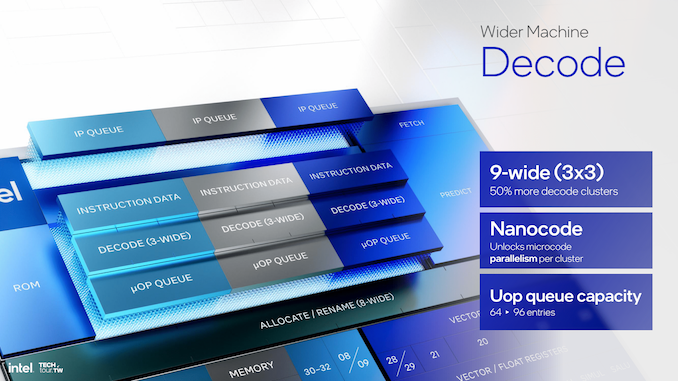
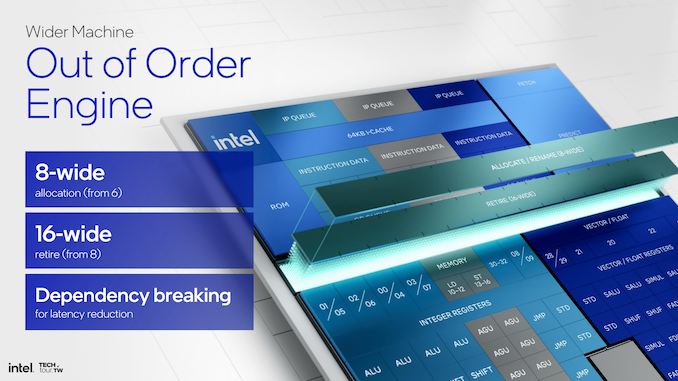
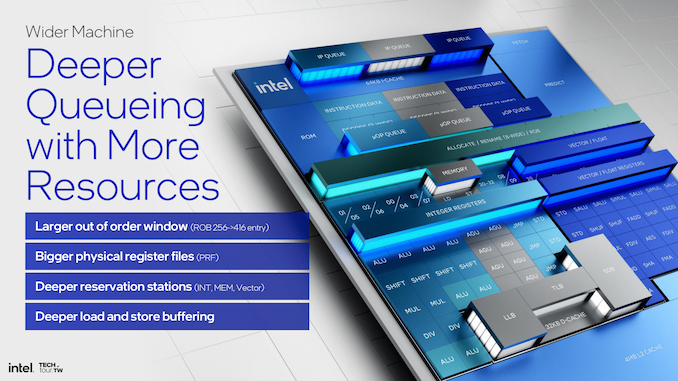


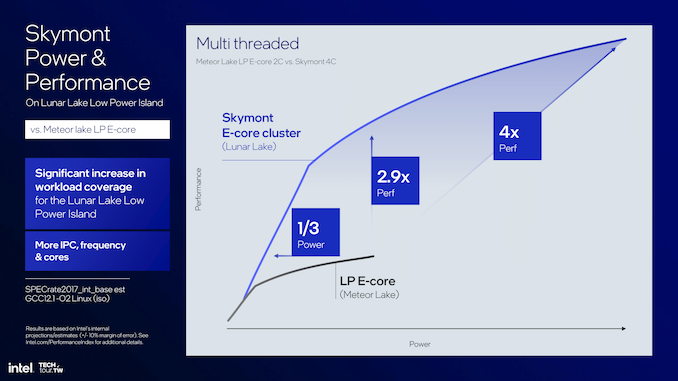
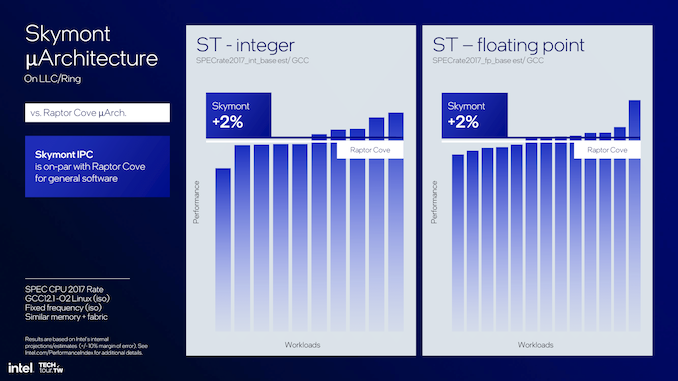
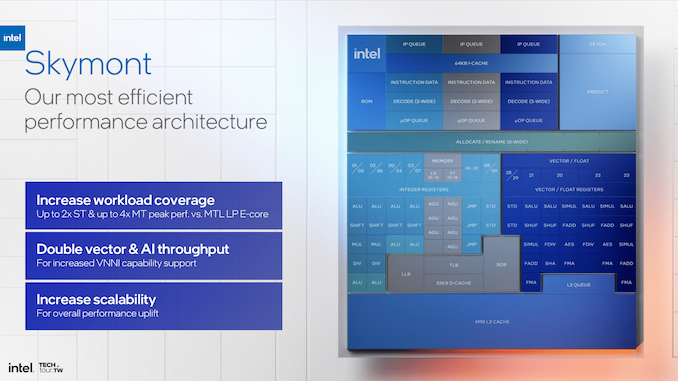








90 Comments
View All Comments
Silver5urfer - Tuesday, June 4, 2024 - link
Disaster for Intel. Finally they folded. Intel fabs are now not even used for their high volume BGA junk processors. Instead using TSMC.Second thing is as everyone pointed out they are comparing LP-E to E cores lol to inflate the graphs. Also the IPC is meager at best, Raptor Cove is faster than Meteor one and they are using that figure.
ARL will lack HT on top of this reduced clockrate, interesting times ahead for Desktop battle. Reply
Drumsticks - Tuesday, June 4, 2024 - link
They aren’t comparing LP E-Cores to E-Cores. LNL E-cores are separated from the LLC, same as MTL island cores. It’s an apt comparison.On the flip side, the comparison to Raptor cove is with E-cores connected to the LLC and ring bus, just as Raptor cove would be. It’s also an apt comparison. You’ll see island E-cores only on LNL (because of the power advantages) and ring bus connected E-cores on Arrow Lake (because of the performance advantages). Reply
Kangal - Wednesday, June 5, 2024 - link
I don't know, but I am pretty underwhelmed.Intel is the least trusted tech giant, even Nvidia look better when it comes to honesty.
Here it seems like Intel took two steps forward, and three steps back. They are probably at a loss in either pricing, efficiency, or performance. Or more likely all three. That's why they use smoke and mirrors and try to trick the viewers/shareholders with the technicalities.
It's not like AMD didn't do the same, but they stand behind their technology, and actually showcased real products. And they also gave benchmarks. That's how you know they are confident.
It seems the CPU and GPU space is going to be a bloodbath for Intel. And we need all the competition we can get. But it is a little amusing to seeing Intel squirm. Ironically Intel is going the way of Bulldozer (shared cores) whilst AMD is sticking with Hyperthreading (extra bits per core) design. It's only amusing because Intel did unethical and illegal business practices that led to AMDs bankruptcy more than a decade ago. Microsoft is also complicit in that.
Reply
Terry_Craig - Wednesday, June 5, 2024 - link
Sounds like an intel employee. People care about performance, not excuses, the problem with the comparison is that the LP-E cores are much inferior to the already deficient E-Cores.https://chipsandcheese.com/2024/05/20/comparing-cr... Reply
Drumsticks - Tuesday, June 11, 2024 - link
Not sure if this was a reply to me because of page breaks, but if it was, what about what I said is untrue or biased?From the (excellent, by the way) Chips article: "I wonder if Intel could give low power Crestmont a larger L2 cache, or even drop some blocks on Meteor Lake’s SoC tile to make room for a system level cache." - this is exactly what was done in Lunar Lake. The LNL E-Cores don't access the same L3 as the P-Cores, but there's an 8MB System level cache that they can access (that the rest of the chip also can I think, P-Cores, GPU, and NPU included). That probably is a big part of the giant 40-70% performance gain they show.
And E-Cores connected to the ring bus ARE much better, by Intel's own admission and by, again, the Chips article. Skymont E-Cores coming to ARL are (presumably) on the ring bus, and should punch much better than LNL E-Cores because of it.
None of this means that Intel's design is the best, or that it's not going to fall flat. That devil is still in the details, which Intel still needs to give to us. But I'm not sure how we can argue that the explicit details of the implementation are somehow biased or an excuse. That IS how Intel designed the chip; whether or not it is a good design remains to be seen. IMO, it seems like a pretty decent concept, but we'll have to see how much power the new P-Cores are really saving. With a 4P+4e design, they will need to be pretty efficient to match what Zen 5 will be up to, even in low power setups. (I assume 15W and above will get an arrow lake design that has more p cores and/or E cores on the ring bus). Reply
Drumsticks - Tuesday, June 11, 2024 - link
One other thought - based on the Chips and Cheese article, LP E-Cores seem to be anywhere from 10-30% slower without access to an L3 cache. That Intel is calling out a 40-70% gain in Skymont LPE core performance over Crestmont LP-E is pretty noteworthy if nothing else. Even at their 10% (which is nuts) margin of error, the LPE core Skymont cores (albeit at least with access to a system cache) are as fast as Crestmont cores with a full blown 24MB L3 cache.Again, benchmarks are king, but assuming Skymont LP-E is bad because Crestmont LP-E was bad seems like a poor assumption given the underlying conditions are completely different. Reply
GeoffreyA - Tuesday, June 4, 2024 - link
On the P side, most interesting is Lion Cove's moving to a split-scheduler design, saying good-bye to their classic unified approach there since the P6. AMD, always thinking ahead, has been using the split scheduler since the Athlon. ReplyBlastdoor - Tuesday, June 4, 2024 - link
This really looks like a SOC made for a MacBook Air. Replylmcd - Wednesday, June 12, 2024 - link
Or intended to beat out Snapdragon Elite if its date didn't slip. ReplyNextGen_Gamer - Tuesday, June 4, 2024 - link
With confirmation that the entire compute tile is made on TSMC's N3B process, I guess we can take that to mean Intel was not super confident in mass yields on its own 20A process. Intel's 20A will be used in Arrow Lake, the desktop equivalent to Lunar Lake. Desktop shipments are a small fraction of laptop chips nowadays, so that makes sense. This does create a really interesting opportunity that I hope Anandtech will explore, where you could take a desktop Arrow Lake processor, disable enough P-cores and E-cores to make it equal to Lunar Lake, and see how they compare. Same architectures, but one on TSMC N3B versus Intel 20A. Reply